E-Archive
Cover Page
in Vol. 5 - September Issue - Year 2004
Complete Solutions for several Surface Treatment Industries
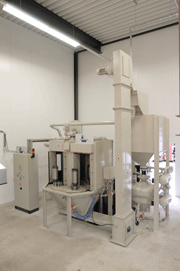
Fire extinguishers exposed to an angular steel grid of type GH-40 in an off-line shot blasting machine
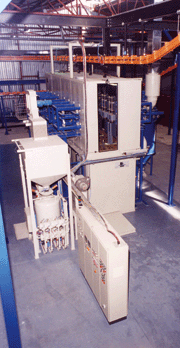
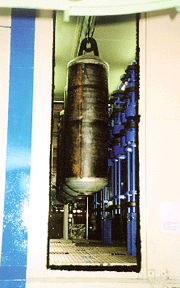
Internal shot blasting of boilers
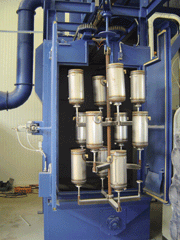
Prior to shot blasting
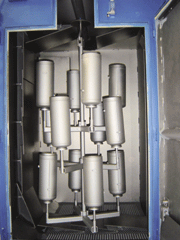
After shot blasting
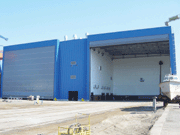
Front view 2 blasting- and painting halls, 30x30x22 meter each
Straaltechniek International in the Netherlands is a renowned manufacturer of surface cleaning machines. Besides its Shot Peening Division, which is known worldwide, the roots of the company are based on experience gained from surface cleaning machines.
The Dutch company has a long history in design, development and delivery of shot blasting and shot peening machines. As a result of the high quality of its machines the aerospace industry is a regular customer since the mid 80s for shot peening machines. The industry for surface cleaning and/or surface preparation however has been served already since the late 50’s.
For this reason lots of end users have decided to rely on the expertise of Straaltechniek International and Straaltechniek International was able to build a huge reference list in the different industries in surface treatment, like:
Industrial subcontracting for surface preparation
Marine industry for shipbuilding and ship repair
Aerospace industry
As a result of the experience gained from all industrial fields, Straaltechniek International moved more towards high end applications for shot blasting and shotpeening, which lead to the delivery of several automated and/or semi-automated shot blasting and shot peening machines for cleaning and/or peening of i.e.:
Internal and external surfaces of gas bottles prior to wet coating process
Internal and external surfaces of hot water boilers, prior to powder enamelling
Internal and external surfaces of the rocket booster of Arianne-5 rocket, prior to wet coating process.
Internal and external surfaces of aluminium motor blocks
Internal and external surfaces of critical aero engine parts
The focus in this article is more on the surface preparation and surface cleaning machines or surface cleaning installations.
Powder Enamelling Industry
In the last 3 years the manufacturer in Holland installed, in combination with some project partners who are all world leaders in their specific field, 4 powder enamelling lines in Europe, for which it delivered the surface preparation machines. The principle of powder enamelling is similar to powder coating, although the temperature of the firing process for enamelling is significantly different from powder enamelling (up to 850°C instead of 180°C to 220°C).
The lines work in 3 stages:
Surface preparation of internal surfaces
Powder enamelling of internal surfaces
Firing of the powder enamel in a furnace
The 3 machines, suitable for the above described processes, are connected with each other by a hanger conveying system, which transports the boilers through the machines.
Using a powder enamelling process with mechanical surface preparation gives the following benefits:
No use of chemical pickling as surface preparation, which is environmentally unfriendly
No use of wet enamelling process, which is also environmentally unfriendly
Perfect resistance against the aggressive hot water (100°C) to be stored inside the boilers
The boilers are entered through a socket in the bottom (Ø30- Ø100 mm) with a rotating lance, which will perform the surface preparation on the inside of the boilers. Angular steel grit is used to achieve the required cleanness and roughness of the internal surfaces, to assure a proper adhesion of the powder enamel to the shot blasted surface. After surface preparation the boilers are transported to the powder enamelling machine, where the powder will be applied with the same principle as for the shot blasting process and there after, the boilers will be fired in a furnace and after this firing the boilers are ready to be assembled.
Machines have been supplied in online execution (for high production capacities) and off-line execution (for regular production capacity). Machines with a maximum production capacity of 240 boilers per hour have been installed and are producing 350 days a year, 24 hours per day.
Fire Extinguisher Industry
As fire extinguishers have the same geometrical shape and behaviour, it was a logical step to perform shot blasting on these products as well.
As one of the European market leaders of fire protection, prevention and extinguishing solutions was planning to move to a new plant, Straaltechniek International was invited to join an internal task group to study the possible alternative ways of production for fire extinguishers. The company was asked to advise the task group for the internal and external surface treatment of the fire extinguishers, due to their longstanding presence in the surface treatment industry in general and the specific experience, gained from boiler powder enamelling industry.
Since 1925 the Dutch manufacturer of fire protection solutions has successfully provided fire protection, prevention and extinguishing solutions. They worked closely together with a world famous manufacturing company where vehicles for the fire brigades were built. This department has recently been sold enabling them to fully concentrate on the production of fire protection material since then.
So far, the fire protection solution manufacturer has used chemical pickling for the preparation of its fire extinguishers. As the new plant should contain the latest state-of-the-art production technologies, the task group was forced by the management of the company to find alternatives to the current environmentally unfriendly production methods.
Straaltechniek International studied the requests from the task group and came up with the following solution:
Using a hanger type wheel shot blasting machine, equipped with the famous Rutten wheels®, which are able to use 100% angular steel grit without creating wear on the wheels and their parts. This wheel machine takes care of the complete external surface preparation of both the powder extinguishers, as well as the complete external surface preparation of the foam extinguishers.
Using an offline shot blasting machine for the internal surface preparation of the foam extinguishers with the use of 100% angular steel grit
The use of angular steel grit was an obligation to meet the criteria of the task group, which required the following test procedures of the coated parts:
External surfaces to be coated with 2 layers powder coating (in total 80-100 microns) and to be tested with a corrosion resistance test (480 hours salt spray test) according ISO 9227
Internal surfaces to be coated with 1 layer powder coating (in total 70-80 microns) and to be tested with a corrosion resistance test (240 hours salt spray test) according ISO 9227
Powder extinguishers only require external treatment before coating. However, foam extinguishers also require internal coating in order to prevent corrosion. Extinguishers were degreased and washed in five different baths of phosphorus. Besides the environmental disadvantages, it took around 15 minutes per bath to treat the extinguishers. Producing 60% powder extinguishers and 40% foam extinguishers, the maximum production capacity was 350 fire extinguishers a day.
For the external surfaces of the parts to be processed, the extinguishers are exposed to an angular steel grid of type GH-40 in the hanger type wheel shot blasting machine. The metal extinguishers are transported into the installation by a lever, where they are blasted for several minutes. The lever turns the extinguishers around their axes and moves forward and backwards. Loading, blasting and unloading of 12 extinguishers of 600 mm takes around 7.5 minutes. Larger extinguishers can be blasted in groups of 8 at a time.
For the internal surfaces of the parts to be processed, the extinguishers are exposed to an angular steel grid of type GH-40 in the off-line shot blasting machine. This machine is executed with rotating lances to enter the extinguishers and to perform shot blasting and cleaning of the blasted extinguishers.
The extinguishers to be processed internally are manually loaded on a satellite table, which transports the extinguishers via the blasting station and the blow-off station to an unloading position, where the parts are unloaded manually as well. This process only takes 45 seconds. In total the purchase of both installations has increased the daily capacity of fire extinguishers from 350 up to 600 extinguishers. This is an increase of 70%.
Next to that this method has improved the quality of the internal as well as external coated surfaces, the process is simplified, which makes operating the installation more flexible under the employees, plus the amount of waste material is reduced tremendously. In short, the solution given by the Dutch manufacturer pays off in costs, time and quality and fully meets the criteria as specified by the task group, which was forced by the management of the company to find alternatives to the current environmentally unfriendly production methods.
Marine Industry
Surface treatment for shipbuilding and ship repair is also a regular industry, which is served by Straaltechniek International. As the history of the Netherlands has been strongly connected to water, fighting the water and discovering the world by sea, the Dutch are world famous in shipbuilding activities. As production of ships becomes more and more a global market, it has moved from the Netherlands to Eastern Europe, Korea and China. Dutch companies however are still strongly involved in the global market, due to their experience from the past.
Straaltechniek International introduced in the early 90’s a revolutionary design for the surface preparation of the ship sections. The design was based on the use of a re-usable abrasive and no longer the copper slag, which creates huge waste amounts, due to the fact that this is a single-use abrasive. Cost reduction of the waste amount was significant and brought lots of advantages for contractors. Furthermore the design of the equipment was based on one-stop shop, which means that the complete surface preparation (shot-blasting, cleaning of internal parts of the ship sections, as well as painting) will be performed in one and the same workshop.
Therefore, the big halls were set up as combined blasting- and painting halls, which reduces the internal transport of the ship sections on the shipyard to a minimum. Furthermore, the contractor is assured that they can perform the complete surface preparation for the ship sections 365 days per year, not dependant on weather conditions anymore. In the past it was common use to perform shot blasting and paint spraying outside, under non-controllable conditions.
The new design of combined blasting- and painting halls is equipped with:
Dust collectors for shot blasting, including recirculation of cleaned air, to reduce the emission into the environment to a minimum
Full media recovery installation to recover the used abrasive to reduce the amount of spent abrasive to a minimum
Vacuum recovery units for the internal cleaning of ship sections and to reuse the abrasive as well
Paint spray dust collectors for painting applications, to reduce the amount of paint dust into the environment to a minimum
Heaters to assure the contractor a stable temperature to perform the surface preparation
Dehumidifiers to control the humidity level inside the halls
The new design of the surface treatment for ship sections was introduced in the early 90’s as environmental regulations forced the shipyards to replace the regular surface preparation methods.
Recently Straaltechniek International has installed several installations worldwide for surface preparation of ship sections.
International Sales Manager
For Information:
STRAALTECHNIEK INTERNATIONAL BV
P.O. Box 65 – 3300 AB
Bunsenstraat 1 – 3316 GC
Dordrecht, The Netherlands
Tel. +31.78.6511477
Fax +31.78.6511401
Email: info@straaltechniek.net
www.straaltechniek.net



























